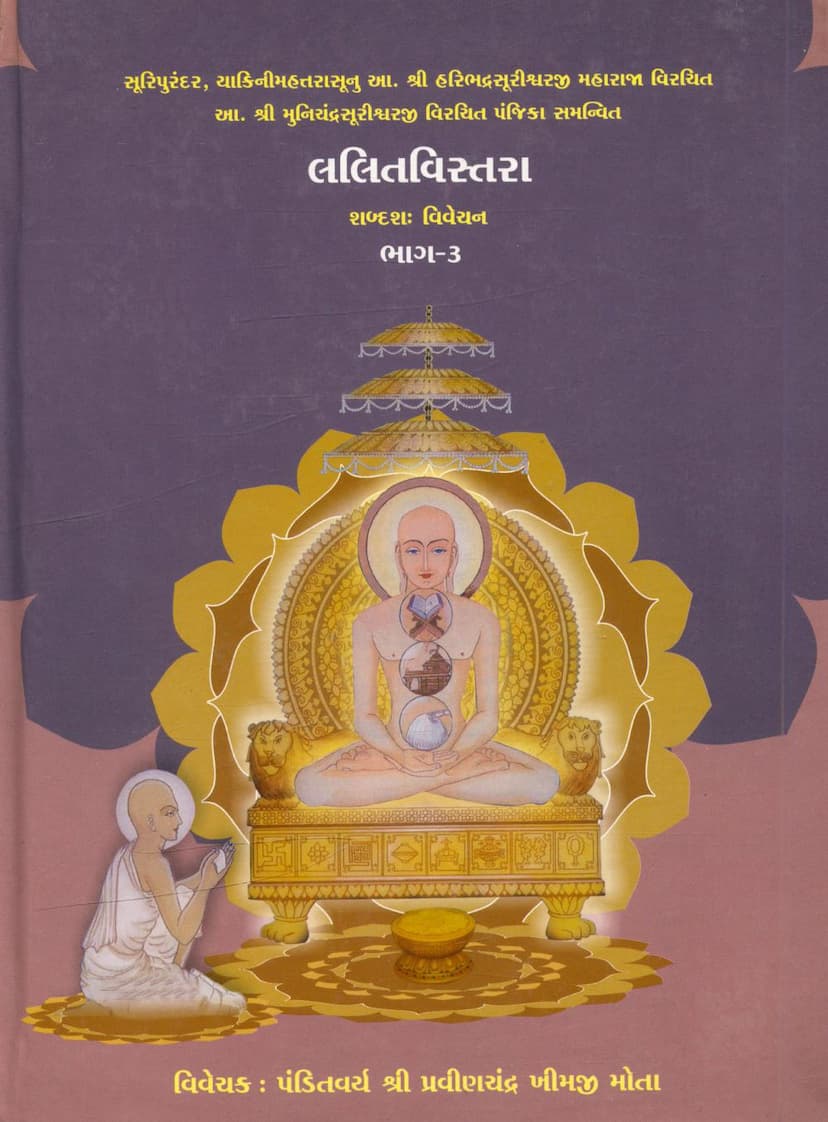Lalit Vistara Part 03
Added to library: September 2, 2025

Summary
This is a comprehensive summary of "Lalit Vistara Part 03" by Pravinchandra K Mota, published by Gitarth Ganga. The book is a detailed word-by-word commentary on the original work by Acharya Shri Haribhadrasurishwarji, with annotations by Acharya Shri Munichandrasurishwarji.
The summary focuses on the content and purpose of this specific volume, drawing from the provided pages.
Book Title: Lalit Vistara Part 03 (શબ્દશઃ વિવેચન - Bhag-3) Author: Pandit Sh Sh Pravinchandra Khimji Mota Original Author: Acharya Shri Haribhadrasurishwarji Annotation Author: Acharya Shri Munichandrasurishwarji Publisher: Gitarth Ganga
Core Purpose and Content:
This volume, "Lalit Vistara Part 03," is the third part of a detailed commentary on the original Jain text, focusing on explaining the verses word-by-word. The text itself, "Lalit Vistara," is attributed to Acharya Shri Haribhadrasurishwarji and serves as a commentary with annotations by Acharya Shri Munichandrasurishwarji. The core aim of the "Lalit Vistara" and consequently this commentary, as highlighted in the publisher's note (Prakashkiya, Page 5), is to reveal the hidden mysteries and profound teachings of Jainism.
The publisher emphasizes that simply obtaining Jainism (Jain Shasan) is not enough; understanding its deep secrets is crucial for liberation. This book aims to provide that understanding by collecting scriptural sayings scattered across various texts, resolving apparent contradictions, and explaining the underlying secrets.
Key Elements Highlighted in the Provided Pages:
- Authorship and Lineage: The book clearly states the lineage of the scholars involved, including the original author, the annotator, and the commentator, indicating a strong tradition of Jain scholarship. Revered figures like Acharyadev Shrimad Vijay Ramchandrasurishwarji and Munipravar Shri Mohjitvijayji are mentioned with reverence, underscoring the spiritual and scholarly depth of the work.
- Commentary Style: The commentary is described as "Shabdshah Vivechan" (શબ્દશઃ વિવેચન), meaning a word-by-word exegesis. This suggests a meticulous and scholarly approach to understanding the original text.
- Content Focus (Implied by Table of Contents and Introduction): While the full content of Part 3 isn't detailed in these introductory pages, the Table of Contents (Anukramnika, Pages 19-22) reveals that this volume delves into specific verses and their detailed explanations. Key Sutras mentioned are:
- Arihant Cheiyana Sutra (અરિહંત ચેઈયાણં સૂત્ર): The commentary explains the significance of this verse, its proper recitation, the underlying philosophical concepts, and the qualifications of those who recite it. It discusses the meaning of terms like "Arihant," "Chaitya," and the intentions behind the recitation (Pujana, Satkara, Sanmana, Bodhilabha).
- Annattha Sutra (અન્નત્થ સૂત્ર): This section will likely delve into the meanings and significance of the Annattha Sutra.
- Logassa Sutra (લોગસ્સ સૂત્ર): A significant portion is dedicated to the Logassa Sutra, explaining the greatness of the 24 Tirthankaras, their virtues, and the benefits of venerating them.
- Savvaloe Sutra (સવ્વ લોએ સૂત્ર): This is likely the next verse in the sequence, continuing the discussion on veneration.
- Pukkharavaradi Sutra (પુખ્ખરવરદી સૂત્ર): This verse is identified as related to the "3rd Stuti" and likely discusses the importance of the Agama (scriptural knowledge).
- Siddhana Buddhana Sutra (સિદ્ધાણં બુદ્ધાણં સૂત્ર): This verse is about venerating the Siddhas, with detailed explanations of their nature and the concept of "Siddhatva."
- Jayaveeraraya Sutra (જયવીયરાય સૂત્ર): This section seems to be about the final verse of invocation, emphasizing the qualities needed for spiritual progress and the importance of righteous actions.
- Emphasis on Devotion and Righteous Conduct: The commentary stresses the importance of internal devotion ("Anubhavi Bhava" – અનુભાવી ભાવ) and the correct understanding of spiritual principles over mere external rituals. It highlights the need for devotion towards Tirthankaras and the teachings of Jainism to achieve liberation.
- Sincerity and Understanding: The text emphasizes that mere recitation without understanding or proper intention is like the "dance of a counterfeit dancer" (कूटनटनृत्यवदभावितानुष्ठान) and is not effective for scholars. True understanding and sincere effort are paramount.
- Guidance for Devotees: The book aims to guide individuals towards understanding the "essence" of Jain teachings, encouraging them to develop a deep reverence and unwavering commitment to the path of practice.
- Contribution of Gitarth Ganga: The publisher, Gitarth Ganga, is presented as an institution dedicated to revealing the secrets of Jainism through various publications, including works by prominent monks and scholars, further reinforcing the scholarly and spiritual value of this book.
- Comprehensive List of Works: The presence of extensive lists of publications by Gitarth Ganga (Pages 7-12) showcases their dedication to spreading Jain knowledge across various philosophical, ethical, and doctrinal topics, with Pandit Sh Sh Pravinchandra Mota's works being a significant part of their critical commentaries.
In essence, "Lalit Vistara Part 03" is presented as a scholarly endeavor to illuminate the profound spiritual insights embedded within Jain scriptures, specifically through a meticulous word-by-word analysis. It aims to guide sincere seekers towards a deeper understanding of the path to spiritual liberation, emphasizing both knowledge and devotion.